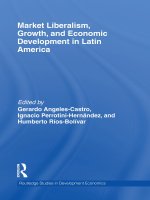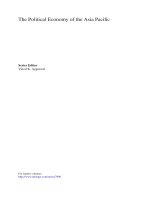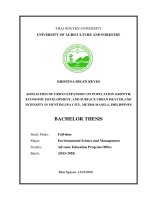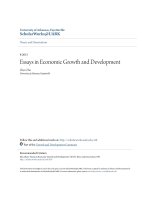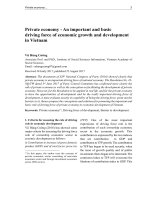Economic growth and economic development 715
Bạn đang xem bản rút gọn của tài liệu. Xem và tải ngay bản đầy đủ của tài liệu tại đây (84.01 KB, 1 trang )
Introduction to Modern Economic Growth
Exercise 15.20. As a potential application of the models of directed technological change, consider the famous Habakkuk hypothesis, which claims that technology
adoption in the U.S. economy during the 19th century was faster than in Britain because of relative labor scarcity in the former (which increased wages and encouraged
technology adoption).
(1) First, consider a neoclassical-type model with two factors, labor and technology, F (A, L), where F exhibits constant returns to scale. Show that
an increase in wages, either caused by a decline in labor supply or an exogenous increase in wages because of the minimum wage, cannot increase
A.
(2) Next, consider the model here with H interpreted as land and assume that
NH is fixed (so that there is only R&D for increasing NL ). Show that if
σ > 1, the opposite of the Habakkuk hypothesis obtains. If in contrast,
σ < 1, the model delivers results consistent with the Habakkuk hypothesis.
Interpret this result and explain why the implications are different from the
neoclassical model considered in 1 above.
Exercise 15.21. Consider the baseline model of directed technological change in
Section 15.3 and assume that it is in steady state.
(1) Show that in steady state the relative price of the two intermediate goods,
p, is proportional to (H/L)β .
(2) Now assume that the economy opens up to world trade, and faces a relative
price of intermediate goods p0 < p. Derive the implications of this for the
endogenous changes in technology. Explain why the results are different
from those in the text. [Hint: relate your results to the price effect].
Exercise 15.22.
(1) Prove Proposition 15.13. In particular, show that in any
BGP equilibrium (15.37) must hold, and that this equation is inconsistent
with capital accumulation.
(2) * Prove that there exists no equilibrium allocation in which consumption
grows at the constant rate. [Hint: show that a relationship similar to (15.37)
must hold, and this will lead to an increase in NK (t), which then implies
that the interest rate cannot be constant].
701
